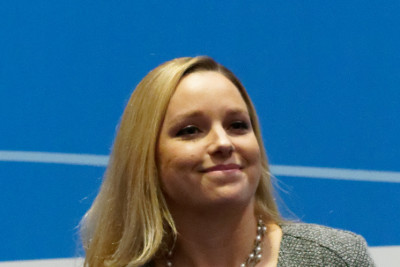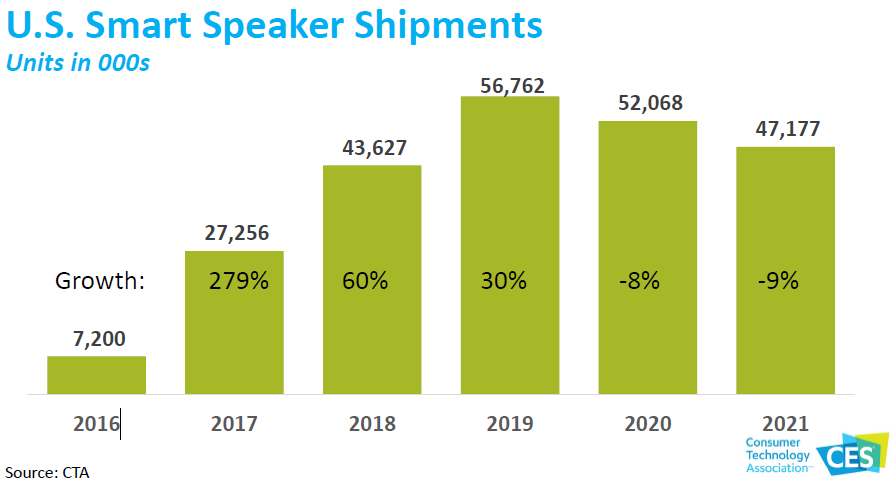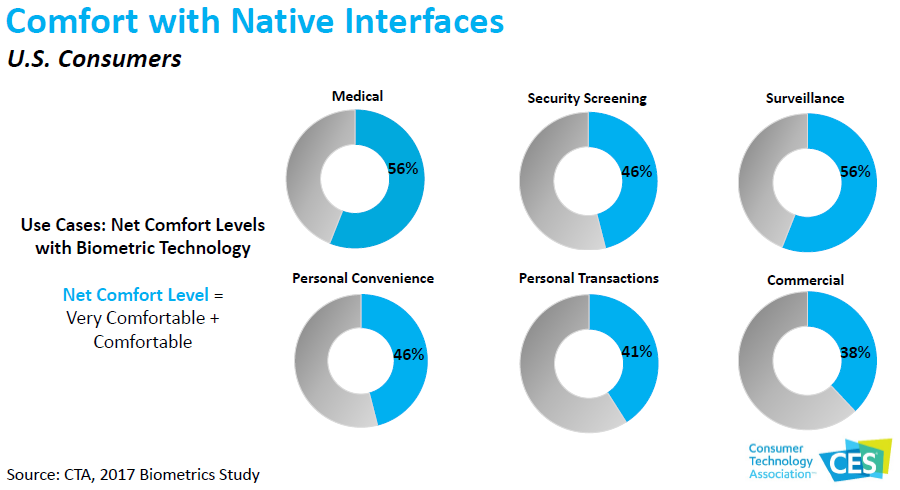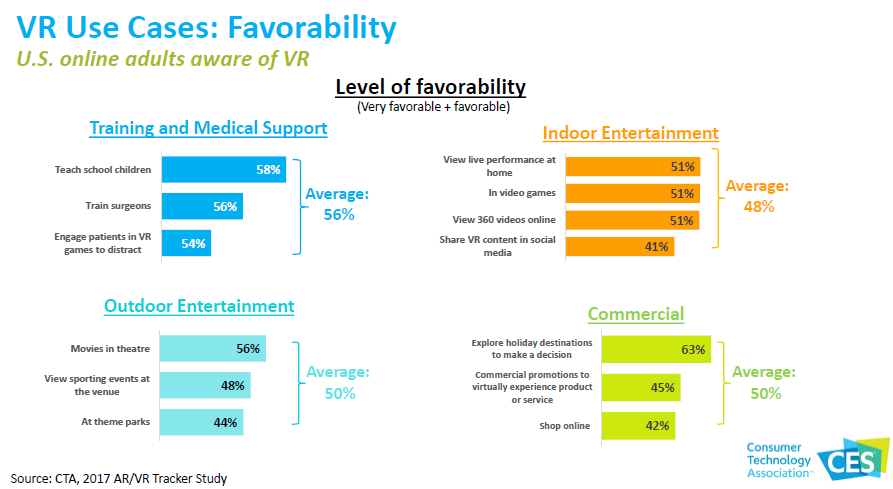The Annual CES event usually kicks off with a briefing on the development of different markets around the world and forecasts for future technology trends, given by the CTA and using data from both the CTA’s research group and GfK. This year, the CTA cut the length of the event and only released data for the US from the CTA. You can download the presentation from the CTA.
The tone of the talk is always relentlessly upbeat and excited, of course. Steve Koenig is a veteran of many of these events (we’ve reported him since 2010) and he started by identifying what he called “Ingredient technologies” and these are 5G/AI/Robotics. They are going to enable and change a lot of other markets. Koenig was assisted by Lesley Rohrbaugh from the CTA.
Koenig started with 5G and AI as we are now in the connected era. The digital era started more than ten years ago with HDTV and MP3 and now we are clearly in the connected age. The next step is the “data age”, he said.
5G is both needed, but also a key enabler. Cities already have millions of nodes and that will multiply a lot with IoT. Low latency is critical for may applications including autonomous vehicles and 5G should deliver that.
 Samsung and Verizon are planning to roll out residential broadband based on 5G and it will also be used in other areas. 5G is very quickly becoming “a real thing”, Koenig said. We’ll start to get into very high bandwidths, although the low latency and fast connection establishment are also important.
Samsung and Verizon are planning to roll out residential broadband based on 5G and it will also be used in other areas. 5G is very quickly becoming “a real thing”, Koenig said. We’ll start to get into very high bandwidths, although the low latency and fast connection establishment are also important.
Downloading a file will take almost no time – he gave the example of downloading a movie such as the “Guardians of the Galaxy” in 3.6 seconds, compared to 26 hours via 3G and 6 minutes over 4G. Standards are being defined at the moment and there are still policy decisions such as finding and releasing spectrum.
What will be possible with new services using 5G, Koenig asked? AI can do things that we don’t care to do, can’t do and where we need ‘all the help we can get’.
This year there are more digital assistants including Bixby from Samsung exploiting AI. The use of voice for control and interaction is clearly about a lot more than just smart speakers – voice will be in many more devices this year. Koenig said that the segment is really expanding fast and is also enabling much smart home functionality.
In the US, the smart speaker market saw 237% growth last year and will have 60% this year and this is “unusually hockey stick growth-like” growth, seen before only, maybe, in the growth of DVD and tablets – it’s a hot category. Smart assistants will also help a lot in automotive – Ford already has Alexa (and we saw a lot more from other makers – Man. Ed.). Why? Consumers quickly like this kind of functionality.
 Smart speaker sales are growing fast, but, like tablets, will peak quickly. Source:CTA
Smart speaker sales are growing fast, but, like tablets, will peak quickly. Source:CTA
Retail can also get a lot of benefit from AI, Koenig said and showed the results of some research by the CTA among retailers. Several B2B markets will really develop, by exploiting AI. AI is improving customer experiences and will be important in business processes as well as IT.
 Retailers see a lot of uses for VR. Source:CTA
Retailers see a lot of uses for VR. Source:CTA
Intel will have the Nirvana neural processor in the future, that has been developed to be able to process AI algorithms and data.
Robotics will see a lot of growth – not to become quite as spooky as Toshiba’s Aiko – but perhaps cuter and more friendly like the Blue Frog Robotics Buddy. (Robots were widely shown at the show – Man. Ed.)
The move to robotics starts with simple single function task-based systems. e.g. the latest robotic vacuum cleaner (from LG, I believe – Man. Ed.) knows where it is in the house when it runs out of battery and can go back to go over the area again once it has gone back to the recharger and is ready to start again.
Mayfield Robotics has “Kuri” which includes face recognition and other features and this is likely to lead to an increase in digital pets/family/ friends and other robotic roles. Kuri can recognise faces so could go around a party taking photos.
What about sleep robots, Koenig asked? Yes, they exist, he said! Somnox has one – “do you sleep with a robot?” may be a question for friends in the future.
Honda is back in robotics, 10 years after its Asimo device, and has several robots at the show highlighting interaction, and mobility.
Biometrics is a Hot Topic
Biometrics is also a big topic this year – as we own more and more devices, we need better and more authentication to ensure that data is secure.
Voice is the fourth sales channel, Koenig said. What does it mean for marketers? What does a brand look like in voice is a question that brands will need to ask and CTA surveys showed that one in five consumers have used voice for checking prices and getting other information when purchasing. Biometrics are becoming very widely used – there are many use cases.
Facial recognition, now part of the iPhone X, of course, is being adopted in other places. Continental has a system in autos that sets all the modes and preferences of a vehicle when it recognises the driver. A demo at the show was of a shopper approaching a car, which recognised her and automatically opened the rear door as she was carrying shopping. (A technology feature that my wife, usually a technology luddite, would actually welcome! Man. Ed.)
US consumers are very comfortable with biometrics, although they are hesitant about its use in commercial spaces – they are not yet comfortable with in-store biometrics.
Koenig showed the chart below that shows where there is concern.
 Consumers’ comfort with biometrics depends on where they are being used. Source:CTA
Consumers’ comfort with biometrics depends on where they are being used. Source:CTA
Reality is Shifting from V to A
AR may start to take the headlines a little bit away from VR which has been leading over the last couple of years. What is reality will start to be a real question as the real and virtual are increasingly seen together. We will start to rely on the digital bits being available (and that’s another reason for 5G).
VR has been used in gaming and for viewing short form content, but is looking to B2B now, while AR was early to B2B applications and will continue to develop there.
New APIs including ARKit will cause a lot of innovation in the A/R space.
Koenig highlighted the Lenovo Mirage Solo which should compete with Oculus Go – it’s self-contained and there are more of this level of VR headsets coming. Koenig said that content creatives are now getting the hang of AR and VR and there are likely to be some really compelling experiences this year. Social apps will also become important.

AR will bring productivity improvements – and the technology will leverage AI and smart assistants – Vuzix, for example, has added Alexa support to some of its AR glasses. CES has a Sport Zone that is highlighting the new fan experiences that can come from AR and other technologies.
Koenig that mobile use will get redefined – there will be more head up and less head down. AR apps are likely to be adopted “big time”, he said.
Smart cities will be a big topic, traffic is a big topic for the US and this year there was a “Smart cities” area at CES in the Westgate. There has been a Smart Cities challenge in the US that was won by Columbus, Ohio. The project started as many do in the US, with traffic. In the EU, projects are more often starting around energy and environmental issues. There isn’t a single path to Smart City initiatives, they may start in any area.
Smarter transportation is getting better with apps in Paris. London, Amsterdam, Helsinki and elsewhere, with users becoming data providers. Waze is already real (at the show, an executive who has a very high end car said he prefers Waze to the very expensive GPS that the maker created). Urban travel is going to increase with forecasts that 66% of world populations will live in cities by 2050.
Sports innovation is interesting and covered at the show with plenty of activity in wearables, smart venues, AR/VR, eSports etc. Services such as Twitch https://app.twitch.tv/ are bringing more excitement for fans and more interactivity to the viewing experience.
Digital therapeutics is increasing rapidly and helping with a number of chronic diseases. Technology can be a big help with monitoring conditions and communicating data to health professionals and may even reduce the cost of medical processes because you already have a smartphone. And cost is an issue in medicine, of course. VR is being used for the treatment of trauma and phobias.
There are a lot of connected devices being sold in the US. Tech revenues are expected to rise by 4% this year after 6.7% growth in 2016.
Analyst Comment
We heard back from Steve Koenig at the CTA that the organisation is no longer working with GfK which appears to have dispensed with the ‘GfK Boutique’ part of its business which offered analysis on the core data. We also heard from other sources that Jürgen Boyny of GfK, who ran the TV forecasting business has been seriously ill – our best wishes to him.
GfK now has KKR, the private equity group, as a majority shareholder. If it was looking to a sale, it might be thinking of polishing its P&L and losing less profitable parts of the business. (BR)

